Matador Network's Blog, page 2256
June 15, 2014
10 World Cup blooper moments
During a Group 2 game against Brazil, Zaire defender Mwepu Ilunga decided to take matters into his own hands on defense during a free kick. Ilunga, part of Zaire’s wall, took off in a sprint and blasted the ball away before the free kick was taken, confusing both the players and spectators alike. The move earned him a yellow card, though Ilunga later stated that he had hoped to earn a red card in protest of the team’s players not being paid.
Andrés Escobar’s an own goal (1994)
In a match against the United States, Andrés Escobar extended himself in an attempt to deflect a pass from John Harkes. Unfortunately, the ball was deflected past the Colombian goalie and into the back of the net. Sadly, this blooper turned absolutely tragic when Escobar, now the subject of several documentaries, was killed upon his return to Colombia. A bodyguard for members of a Colombian cartel, Humberto Castro Muñoz, was charged with Escobar’s murder.
Roberto Baggio’s penalty kick (1994)
Roberto Baggio is considered one of the greatest players of all time, but his famous penalty kick during the 1994 World Cup final against Brazil is a blemish on his career that few Italians have forgotten. Baggio aimed to place the ball in the direct center of the goal, knowing Taffarel would dive in one direction or the other. Taffarel dove, but Baggio’s shot sailed way over the crossbar, costing Italy the cup.
Rene Higuita vs. Roger Milla (1990)
Known for his showmanship and risky style of play, Colombian goalie Rene “El Loco” Higuita was stripped of the ball 35 yards from his own goal by Roger Milla during a World Cup match against Cameroon. Milla left “El Loco” in the dust and scored on an open goal. For those wondering what Higuita was doing so far from his goal, well, that was one of his trademarks.
Diana Ross’s penalty kick (1994)
Less heartbreaking than the other moments on this list, Diana Ross performed during the 1994 World Cup opening ceremony in Chicago. The performance was meant to be completed with a penalty shot at a makeshift goal, which would split in two as the ball ripped into the back of the net. She missed the shot. The goal still split in two, making it all the more awkward.
Rivaldo’s high drama (2002)
Players are known for taking dives and putting on performances worthy of Academy Awards during the World Cup. Rivaldo made sure no one would forget his. Upon being struck in the knee by a soccer ball kicked in his direction by Turkish player Hakan Unsal, Rivaldo gripped his face, threw himself to the ground with force, and began writhing “in pain.” The Oscar-worthy acting performance earned Unsal a red card. “It doesn’t matter where the ball hit me. It was the intent that mattered,” said Rivaldo.
Josip Simunic’s third yellow (2006)
Typically, two yellow cards warrant a red card, upon which a player is removed from the game. Graham Poll, the officiating referee during a 2006 World Cup match between Croatia and Australia, forgot about this rule. Poll penalized Josip Simunic with two yellow cards, but for some reason allowed the Croatian player to continue. It was only after a third yellow that Poll pulled out the red as well, sending the player off the field.
Jimmy Greaves’ new friend (1962)
During a 1962 match between Brazil and England, a stray dog ran onto the field. The dog evaded every player’s attempt to catch it until Greaves was able to do so by getting down on his knees and calling the dog over. He was rewarded for his valiant efforts with dog urine all over his jersey. England lost the match, too.
Yakubu’s one-in-a-million miss (2010)
Nigerian striker Yakubu had a chance at an open goal during a 2010 World Cup match against South Korea. Mere yards away from the goal, he received a pass (which the goalie unsuccessfully attempted to stop) and was left with an open net in front of him. His foot met the ball, which veered just left of the goalpost. Yakubu redeemed himself by scoring on a penalty kick later in the game, but the final score of 2-2 was not enough for Nigeria to advance past the group stages.
Robert Green’s fumble (2010)
Robert Green was selected last minute as England’s goalkeeper for the 2010 World Cup opening match against the United States. In the 40th minute, American Clint Dempsey fired off an on-goal shot, which appeared a relatively straightforward stop for Green. But the ball bounced in and out of his hands, rolling into the goal. All he could do was watch. The match ended in a draw, and not long after, Green was dropped from the team. 

June 14, 2014
Watch: A gorgeous video of Indonesia
Indonesia has never been on my travel radar. For whatever reason, I’ve only ever wanted to go to the countries around it, like Malaysia, Papua New Guinea, Australia, or the Pacific island nations.
But a pair of videos on Vimeo have completely turned that around for me. One of them, showing a filmmaker’s surf trip in Indonesia, I’ve already written about, but this week, I stumbled across a new video by filmmaker Nhi Dang, and it looks incredible.
As far as I can tell from the two videos, the Indonesian archipelago may well be one of the most beautiful places on Earth. 
A Father’s Day open letter
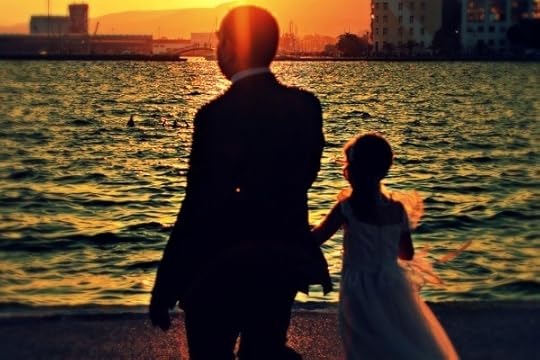
Photo: Christos Loufopoulos
To my Dad, with immense gratitude for how you support my travels.
Dad,
When I was little, I didn’t know what I wanted to be or do when I grew up, but I knew I wouldn’t, couldn’t be like you. You, with your 70-hour workweeks driving trucks, reporting to a boss you couldn’t stand. Your doing Every. Single. Thing with “elbow grease,” when all I wanted to do was slide by and find the easy, fun way out of a project. Your chosen lifestyle seemed like hell, and I didn’t understand you. I could only focus on the chasm of glaring differences that divided us.
On Sundays, you’d spend your precious little free time perusing National Geographic magazines, traveling far and wide for an hour or so, if only in your mind. You’d talk about distant lands with conviction and passion, like you actually knew the places you were talking about. It was painfully sad to me, realizing deep down that no matter how much money you and mom managed to save, it would always go to fix the septic tank or to buy me new skis. Never in a million years would you use it to get on a plane to actually experience those foreign lands that attracted you so. That’s another way we were different — everything you did was for the benefit of others. I already knew I was much more selfish than that. I knew as an adult I’d more likely say to hell with the septic tank and take off on the first flight to a place I couldn’t pronounce, and I felt like an outsider in our family because of that.
Living my dreams full on, following my heart, is my gift to you.
Our family vacations pissed me off, and I never told you. I didn’t want to go eat fudge yet again at Mackinaw Island. I didn’t want to go stand in three-hour lines in the scorching sun for the rides at Cedar Point, even though I logically understood that these were the vacations that were possible, time-wise, comfort-wise, and money-wise, for our family as a whole. I should’ve been grateful for these trips, but instead I was really mad at you that we couldn’t go dogsledding together in Siberia. Or spend the night under the stars in the Sahara. Or drink some interesting ‘voodoo juice’ together deep in the Amazon. I blamed your blue-collar job and your put-responsibilities-first attitude for my inability to travel how I wanted. Really, I didn’t get it. I didn’t get at the time that anything I sincerely wanted and actually voiced, no matter how grandiose, you would have bent over backwards trying to make happen.
It’s taken me a while, Dad, to realize that even though you’ve never been out of the country, you of all people made me the traveler I am today. In high school when I wanted an exchange student (I think at the time I wanted her almost like a pet, nothing more than something exotic to play with, to distract myself with), you instead made Sandra family. You took every opportunity to get to know her, to make food with her, to talk, laugh, and communicate with her family as though they were long-lost friends of ours. You took such genuine interest in getting to know her culture, and I saw how deeply you were able to connect with her. For the first time, I was able to admit to myself that you inspired me. You had a skill I knew I wanted to learn.
I know you had such high hopes for me, your National Honor Society golden student, signed up for the Air Force Academy. (I’m still laughing at the ridiculousness of the idea of hippie me, there, flying a fighter jet. Wtf?) Only I came home from school one day to tell you I called the Academy. I told them that instead of flying their planes, I intended to road trip solo, camping my way across the US. Instead of raging with disappointment in me, which I totally knew was well within the range of possible outcomes, you took me to MC Sporting Goods to look at tents. If your daughter was going to say fuck everything to camp, of all things, then dammit, she’d be doing so in the best tent you could afford! I take that lesson with me now, with my own kids. If my daughter wants to be a surfer, so be it. No matter that we live in the middle of the Andes. I’ll get that girl on a surfboard no matter what, because thanks to you I know how wonderful it feels to have dreams be supported.
When I realized that being a suburban soccer mom was not for me and bought one-way tickets for me and my family to Argentina (not knowing Spanish, not ever having been there, and not having a plan), you had the right to be mad. I was taking your beloved grandkids very, very far from you, and for what? A whim? But do you remember what you told me as you brought my luggage out to the car, when you were going to drive us to the airport? You stopped me in the stairwell, our last moments alone. You got choked up. You said one simple thing before your tears started to fall: “You’re doing something I never had the balls to do.” And I couldn’t stop my own tears for most of the four-hour car ride. Those words guide me today. I made a decision at that very moment to live, all balls out. Not just for me, but for you. Because you lived your entire life doing what you felt was best to support me and the rest of the family. It’s the least I could do in return. Living my dreams full on, following my heart, is my gift to you.
You get me at my core. You have the wanderlust deep inside.
It couldn’t have been more than a week later, when I Skyped you the first time from Argentina, when I saw you’d already traded your favorite University of Michigan “Go Blue” shirt for one that instead said “Vamos Azul!” I told you how dorky it was, but I actually loved it. I knew you wore it just hoping, hoping, that some Latino somewhere would stop to chat with you, and it would give you the opportunity to tell them all about your daughter who was living in Argentina. Your pride warmed my heart, and I realized that even though you were thousands of miles away, we were in this move together.
After all these years, I realize even though when I was younger I wanted to focus on our differences, you get me at my core. You have the wanderlust deep inside. You feel the magnetic attraction to the exotic, to the unknown. You have the traveler’s spirit. When I had to return to the US to go through my ugly divorce, you gifted me, of all seemingly random things, Greek cooking lessons to cheer me up. It was perfect. You understood intuitively that my world would feel small while in your conservative Midwest town, that I’d want a foreign fix. We watched endless Anthony Bourdain reruns together, and I loved pointing out to you the places I’d been to. I actually felt much more accomplished in your eyes in those moments than had I turned out to be that fighter pilot. And in custody court, you stuck up for me, even though it could’ve been all too easy for you to try to convince the judge to keep your grandkids in the US. You said your grandkids would be healthiest when their mom was the happiest, and you knew I’d be happiest living like a free little bird in my mountain refuge on the other end of the world. That selfless support meant the world to me.
Sometimes I’m so happy I feel guilty. Sometimes I don’t even share with you some of the places I’m at while working as a travel writer because I know you deserve being there more than I do. You worked your ass off your whole life and never once got to leave the country. I want you to know I order scotch when I do restaurant reviews, even though I hate it, because they’ll give me “the good shit” that you’d appreciate and should be drinking. I order steak even when I really want hummus or quinoa, because it’s a world-class steak that you should get to eat that night. I go fly fishing, just because it seems like something you’d really like. I climb mountains sometimes for nothing more than to make you proud of raising the kind of daughter who climbs big mountains.
I know more times than not having a daughter like me is probably any parent’s nightmare. I do everything most parents don’t want their kids to do. I hitchhike alone. I sleep on strangers’ couches. I don’t check in nearly as much as I should. I walk myself home alone at night. I never know where my phone is. But rest easy knowing you raised me right. You instilled in me a good base of common sense (whether that may be apparent or not). The ability to stand up for myself. To see through people’s bullshit. And the feistiness to unflinchingly deck anyone along the way who may try to mess with your baby girl. I “keep my nose clean” (although until this last year I always thought that expression was just a way of advising me to not snort coke).
You’ve taught me to be able to shoot the shit with anyone, anywhere. You’ve taught me, when I do luxury hotel reviews in some pretty pretentious places, to keep it real. (“What, these people think their shit don’t stink?”) You’ve taught me what it means to celebrate people and to value friendships, both old and new, both lasting and fleeting. To be a good guest and an even better host. To have a plan B and a plan C and a plan D, and to know when to say screw it all, scratch all plans, drink that glass of scotch, and just go with the flow.
On the outside, you’re the antithesis of my ideal travel partner. Your back couldn’t make it one night sleeping on a hostel bed, let alone in a tent. You wouldn’t carry a backpack. Climbing a fence, running to get to the train on time — not likely. You’re a loud, larger-than-life, stereotypical gringo with too much luggage and probably too many scheduled plans. But the older I get, the more I’d give anything to travel with you, of all people.
While I know your bills at home and your declining health do not make international travel super likely, I have not given up on the idea. You always supported my dreams, and I want to support yours, no matter if we get there when you’re 90. Better late than never. I want to take you to Lithuania, help you find where your parents were born. We’ll eat kugelis and drink trauktinė. I want to take you to hang out with some shamans in the Amazon and be by your side when your mind is blown wide open and you end up giggling for hours at the wonderfulness of it all. I want to take you fishing in Argentina, followed by an asado de la puta madre, getting tipsy with you on malbec until we’re both singing Martin Fierro poems with the gauchos.
And if for some reason it’s not in the deck of cards for us, Daddy-o, I want you to know you’ll have traveled regardless. Your unconditional support constantly ignites my traveling spirit, and I feel your presence and your guidance no matter where in the world I end up. I really do consciously honor you with every adventurous step I take to follow my passion. Our passion. Thank you from the bottom of my heart for having sacrificed some of your own dreams so I could be sure to live out mine with gusto. 
June 13, 2014
8 lessons I learned from a dirt bike
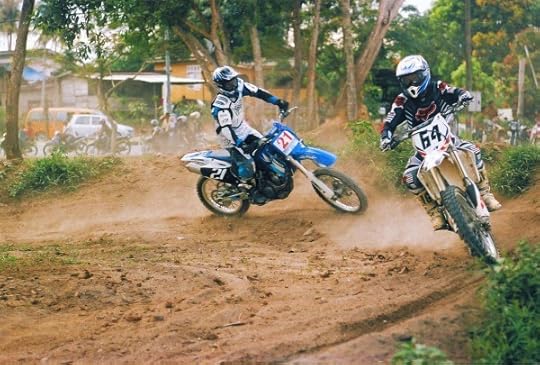
Photo: Fadzly Mubin
1. When you want to do something, dive right in without thinking.
I was waiting tables outside in the East End of Portland when I saw them. Five extremely beautiful women maneuvering a bright purple Yamaha and a sexy black Honda Rebel with an attached sidecar into one parking spot just five feet away from where I stood on the sidewalk. They were laughing and beautifully-sunbleached-hair-tousling as they took off their retro chic helmets and strutted into the restaurant. As the door shut behind them, one man on the patio said what we were all thinking, “DAMN!”
Three weeks later I was hoisting my leg over a 2004 Honda CRF150f that I had tracked down in Auburn, Maine. My toes barely hit the ground and I could feel all 240 pounds of the machine sitting awkwardly underneath me.
“Ya look real cute on her!” offered the man trying to sell me the thing. He was standing on the sidewalk with his big arms crossed over his big chest, wearing a United Steelworkers sweatshirt. His two preteen sons stood silently by his side. “Should we load her up or what?” he asked.
As I shut the truck door and rolled down the window to wave goodbye I heard him yell, “When you’re done with this one, get yourself a Harley!”
2. Learning something new is not easy.
Kick-starting a dirt bike that you can barely sit on is difficult. Kick-starting a dirt bike that has been sitting in a garage all winter is even more difficult.
I definitely cried a little bit. I felt stupid because I was wearing a brand new Honda sweatshirt and I couldn’t even start my Honda that I had withdrawn from my savings account to buy. And I’m 25 years old and can barely afford to shave my legs.
I blamed it on the boots I was wearing (totally unrelated). I jumped way too hard in frustration and the bike fell on me, and pinned me awkwardly against a wheelbarrow, and I had to yell for help.
Basically, I acted like a huge pussy.
But after two days and maybe 267 kicks, I got her started. (Then I cried again because I was pissed it took me that long. And I didn’t even feel like riding anymore.)
3. Don’t confuse things for things that they are not.
Do not confuse a clutch lever for a front brake lever. A clutch lever is never going to be a front brake lever no matter how much you want it to change.
4. Always be prepared.
Get everything you need to give yourself confidence. The triple-certified helmet. The new tires. The extra clutch levers. What’s that kid got on? Fucking badass-looking boots? Get the badass-looking boots.
5. Don’t pay other people to do your dirty work.
Because literally thousands of single teenage boys who haven’t gotten laid yet are on YouTube. And they have spent their quality time making detailed how-to videos on oil changes so you don’t have to walk into a motor sports shop and ask, “What is oil?”
If you’re going to ride a machine, learn how that machine works or it will ride you.
6. Power is a beautiful and addicting thing.
Once you taste a little bit, you’re going to want more. And dirt bikes are a gateway drug.
You can start small, but don’t start too small. If you’re like me, and you can see yourself absolutely killing it on a 1968 Bonneville T120R in a few years, then start on something you can grow into. (Even if it takes you two days to start it and an entire month to get it into third gear.)
7. You are going to fall.
There are two types of people in this world, those who have gone down and those who are going down.
8. Don’t envy a badass. Be a badass.
When I stood on the sidewalk in a mustard-stained white apron and evidence of a keg-explosion splattered all over my chest, I was almost pissed when those women walked by me. Some cynical, bitchy, scared part of me was a little bit angry that women that tragically hip even existed.
So I took a leap. And I can tell you from experience, coveting a 249cc engine in the parking lot is nothing compared to strapping one between your thighs. 
Meanwhile, in the Philippines [vid]
At Cebu City Zoo in the Philippines, they’re trying to make the zoo more “interactive” — you can now get a massage from four 20ft Burmese pythons. The massage consists of simply putting the pythons — totally 250 kilograms (550 pounds) — on top of you and letting them sliver all over your body.
In case you were wondering, yes, a Burmese python is totally capable of killing you through constriction, and can deliver a pretty mean bite as well. But the zoo feeds each of the pythons “ten or more chickens” prior to each massage in order “to curb any hunger pangs.”
I should note that, according to Wikipedia, “Burmese pythons are opportunistic feeders…they will eat almost any time food is offered.” On the plus side, the massage is free. 
Notes from a father-daughter trip
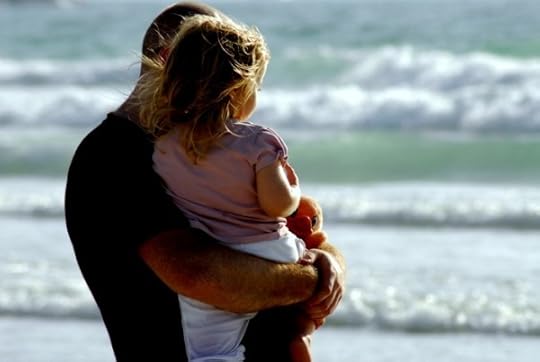
Photo: Hamama Harib
MY PARENTS DIVORCED when I was three. I stood to the side while my dad tried to figure out how to adjust the pleats of my school uniform. “I’ve never ironed a skirt before,” he said. In a row of girls wearing black leather shoes and lace socks, I wore hiking boots and wool. Neither one of us had ever heard of starching a skirt.
With divorce came dating, then step-parents and an ever-changing mix of families. Only our father-daughter trips remained the same.
In the passenger seat of a beat-up Pathfinder, I tapped my feet against the floorboards and listened as he told stories. He always did the accents. We spent hours driving across state lines, exploring wide expanses of public land.
He took me to the woods before I learned to walk. Sitting on weather-beaten picnic benches, we watched the Pacific roll into the rocks and then slide back again. We read Mark Twain and Thoreau, stared at the stars, followed one another’s bobbing headlamps into the damp corridors of underground caves, stretching out afterwards on warm rocks, watching the lazy flight patterns of turkey vultures.
In Colorado, riding along a dusty horizon with the scent of burned cattle hair clinging to our clothes, he commented on the weather, the scenery, the horses, the food. I kept my thoughts to myself. The more people pushed, the more I retreated. My dad learned to wait.
On the shores of Yellowstone Lake, trying to reel in anything that would bite, I asked if I could take a kayak out alone.
He tightened the straps of my life vest and stood on the shore as the red kayak cut through the eddy and out toward the lake. The wind swept the water into white-capped peaks, pushing me farther from shore. I panicked, unable to paddle against the current or the wind, screaming for help. After he had rescued me, after we had tied up the kayaks and put away the fishing tackle, he said, “I’m proud of you, kiddo.”
I threw a rock into the lake. “I couldn’t do it.”
He flicked the brim of my baseball hat, pushing it up and away from my eyes. “You were brave enough to try.”
We didn’t catch any trout that night. I poked a stick into the campfire, watching the embers sputter and then smoke.
In college, halfway through a biology degree I didn’t want, frustrated with my introverted nature and my ever-present fear of failure, I called my dad.
I wanted to ask if he remembered our trip to Yellowstone. And I wanted the mountains. I drove the six hours home. Immersed in the scent of the Sierra Nevada, tapping my boots against the leaves, I tried to explain how I felt sheltered in the mountains, how I wanted to trust people, how it takes time. How when you feel too much, you learn to pretend you feel nothing at all. How when it’s impossible to become impervious, you learn to become elusive.
I was eleven again, throwing rocks into the lake, mired in my own disappointment and unable to see the merit of having tried. He reminded me. With only the trees, the smallest birds flitting from one branch to another, I felt bigger than myself. I hinted at dreams. I wanted to say thank you. I never did. It’s not too late, but I couldn’t find the words.
I don’t know much about child development, about the impact of divorce or of incessant uprooting. But I know that in a constant flux of moving and change, of people entering and exiting, those father-daughter trips gave me a pathway to myself. I know that under his guidance, within the boundaries of North America’s public lands, the courage to try became the mantra of my heartbeat, the open road became a kind of therapy.
Because in spite of my fears and all my hesitation, I have failed spectacularly, turned it into a sort of art. I have fallen hard, skidding into mistakes, wheels spinning, emerging bleeding and broken from clouds of dust. And I have never learned to give up. Because there is a version of me standing on the shores of Yellowstone Lake with bruised knuckles and bluish lips. She remembers. She has faith in her father’s words; she fights hard to go her own way.
And he won’t take credit for it. But he should. Because while he stood helplessly in the feminine care aisle, wondering how to teach her all the things she might need to know about being a woman, he overlooked that the most important thing he’d ever give her is the courage to be herself.
From the passenger seat of a beat-up Pathfinder, under desert skies, along dusty trails, from the bow of an old red kayak, she learned to live, to travel, to cling stubbornly to her own ideals, to take wrong turns and hard falls, to find solace in the mountains, to never learn to starch a skirt, to stay within her head because she likes it there. And when she is thousands of miles off-course, feeling homesick and alone, she will always know where to go. There will always be Yosemite, there will always be Yellowstone, there will always be a place outside with a wide blue sky and her father’s voice saying, “Be brave enough to try.” 
Meet the ultimate World Cup 2014 fan
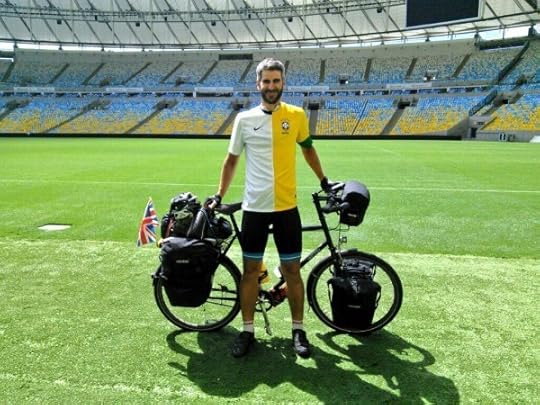
Andy Smith at Maracanã stadium in Rio de Janeiro.
All photos courtesy of Andy Smith, unless otherwise noted.
Let’s just assume we’ve all had enough on-the-road experience to know the grind of typical traveler small talk: “Where are you from?” or “How long are you traveling for?” we mechanically ask each other, most of us just on the same backpacker trail with a few detours. This isn’t the case when it comes to Andy Smith, or, as he’s known on the road: Smudger.
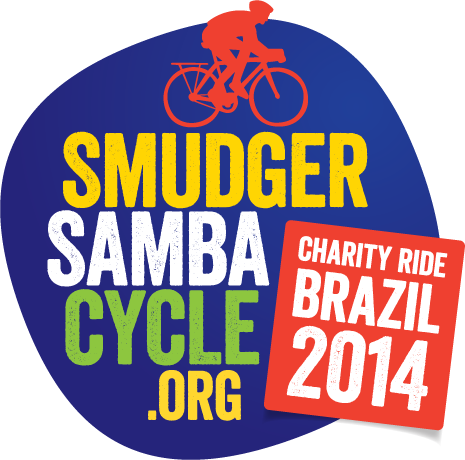
The 35-year-old Englishman has spent the last five months on a 5,500-mile whirlwind assault, dubbed Smudger Samba Cycle, to all 12 stadiums in World Cup host cities spread out around Brazil. With the world’s largest sporting event now in full swing, the lifelong Watford FC supporter is finally getting off his bike to attend all of England’s matches.
The journey’s wide media buzz has helped Andy spread the word on his commendable charity campaign, as he raises donations for Laureus Sport for Good Foundation and Watford FC’s Community Sports and Education Trust. In the words of Smudger himself, “they both provide community sports-based projects for people that need activities, training, education, and positive aspirations.”
I had the opportunity to meet up with the football-crazed fan in Salvador, where he joined me on my free walking tour. And now I’m chatting to him again as he approaches the last leg of his bike journey in Manaus. You can read more of his stories on his blog.
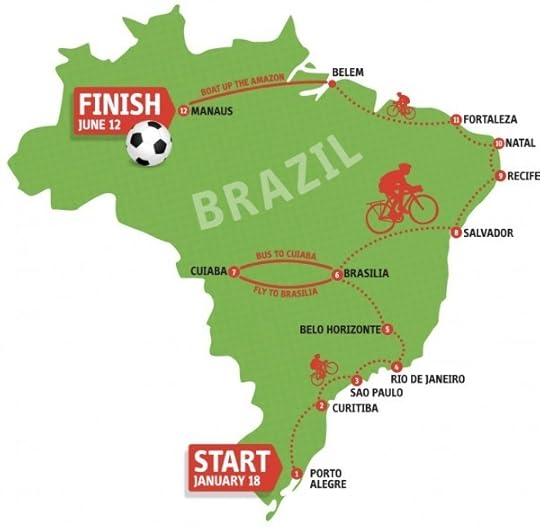
A map of Andy Smith’s whirlwind journey.
SF: You’ve kind of become a mini-celebrity in some parts of Brazil. Is it strange being recognized? And let’s be honest, are you tired of answering the same interview questions yet?
AS: Yeah, I’ve been recognised a lot when cycling on the day or two after leaving cities where I had local, or even national, media coverage. It’s weird, because I’m just a normal guy from England, so nothing like this happens to me back home. But I’m really glad the Brazilian people like my journey. And, no, I’m not tired of answering questions yet. I just hope I get across how amazing Brazil is to people reading about it for the first time.
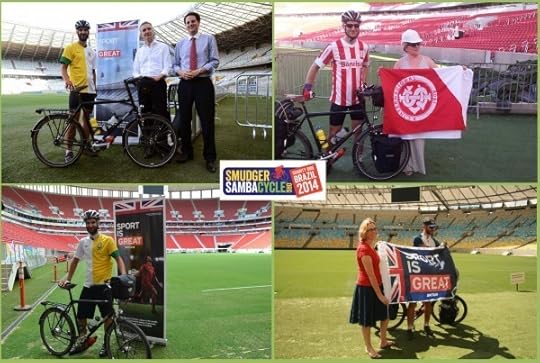
Andy Smith with the British Ambassador and Consuls at different stadia.
You said you knew Brazil 2014 was your dream World Cup before even stepping foot in the country. Why?
I think it’s fair to say that this country loves football more than any other, so combine that passion with the beautiful landscape, people, music, and culture here, and how can it not be a dream location for any football fan? I can say for sure that every World Cup host city is different in unique ways, so the fans will love exploring whichever destinations they visit.
You used to call yourself a Management Accountant. Do you ever think about your desk back in London?
I’ve been told a lot that I’m ‘brave’ to quit my job in London and travel across Brazil alone, but I think it’s the most sane decision I’ve ever made. I wasn’t happy doing what I did before, so I made a radical change in order to do something that I’m passionate about instead. So no regrets at all.
You’ve stayed in an abandoned ‘horror-movie’ house, a fairy castle, and, ‘by accident,’ you stayed overnight in one of Brazil’s infamous love motels. Tell us what really happened there.
Some days I don’t know where I’ll stay overnight until I get there, and so sometimes bizarre things happen. The love motel was hilarious, since I twigged what it was whilst checking in but carried on anyway since the sun was setting, and therefore I didn’t want to cycle any further that day. I felt very self-conscious pushing my bike — ironically named Legover at the time — along the corridor to ‘our’ room, but once inside I decided to make fun of the situation and started posting photos and comments on Facebook, which got lots of replies from friends around the world.
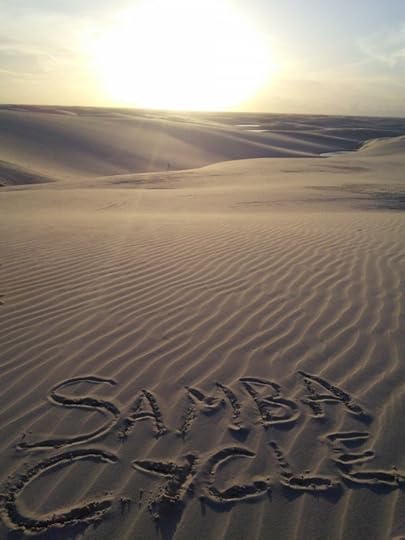
The sand dunes of Lençóis Maranhenses National Park.
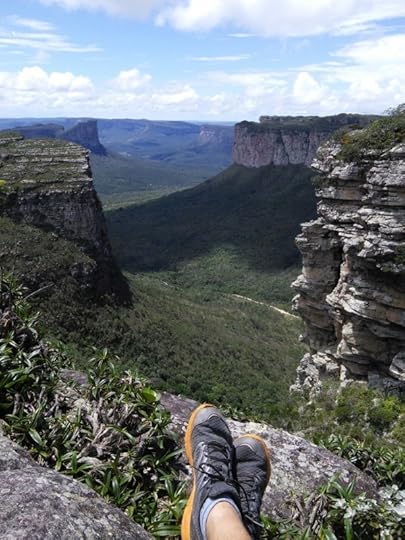
Chapada Diamantina National Park in Bahia state.
You seem to be good at finding yourself in some weird situations, like being in a religious cult theme park and a town crazed for UFO spottings. What’s the oddest thing you’ve encountered so far? Did you join a cult or see any UFOs yourself?
I think the oddest has to be the religious community at Vale do Amanhecer because they’ve created such a unique and colourful place with all the strange buildings, costumes, and ceremonies. I’ve never seen anything else quite like it. And I may be unfair to call it a cult, but since they apparently recruit new members by bringing homeless and ex-alcoholics here, then I think there’s a form of brainwashing going on, since it’s easier to make desperate people into believers. No doubt they have a better life here, though, so I’m not criticising.
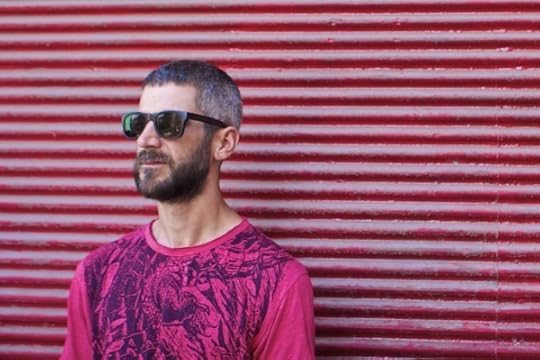
Andy Smith and his bushy beard hang out in Salvador’s historic centre on Salvador Free Walking Tours. Photo: Author.
So you’re currently single. Do you think all the international media coverage might have boosted your dating profile when you return to London?
I doubt it, since no one apart from family and friends seems to be taking much notice of my adventure back home, judging by the charity donations so far. Also, I doubt the bushy beard is helping my image with the ladies.
How do you feel about Brazil’s preparation for the World Cup? What are your expectations for the tournament?
Let’s be honest, the preparations are far from ideal. I was pretty shocked by the unfinished stadia I witnessed in Curitiba, São Paulo, and Cuiabá, but the main issue is the related infrastructure around the stadia that hasn’t materialised in many host cities, which is a great shame. However, the international fans arriving soon won’t know any different, and they’ll have an amazing time in Brazil enjoying the fantastic cities, carnival atmosphere, and exciting football.
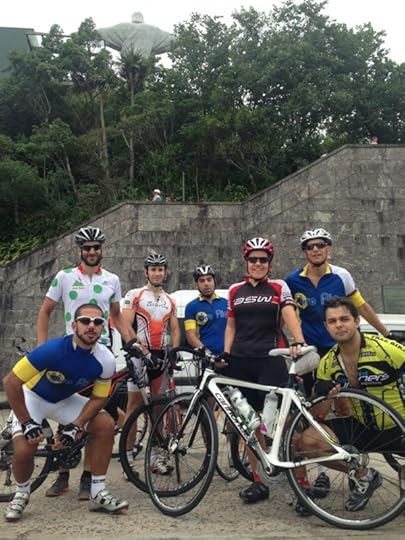
Andy Smith (back left) with a group of cyclists at Christ the Redeemer in Rio.
Is England going to win?
England will lose on penalties in the quarterfinals, as per usual. I predict a Brazil versus Spain final with the Europeans breaking the hosts’ hearts by retaining the trophy.
There’s been lots of controversy around this year’s Cup. Despite that fact, can you feel the football fever gripping the nation?
Of course I’m here to celebrate this World Cup, so it’s been difficult to see people protesting against it, but during my journey I’ve learnt a lot about the reasons for these protests. And of course I understand their fundamental argument that it cost far too much public money to construct the 12 stadia. But I really do feel the excitement building now amongst the vast majority of Brazilians, and hopefully the political debates can be put to one side for the next month, and everyone will come together to enjoy an incredible World Cup. 
21 surprising facts about Costa Rica
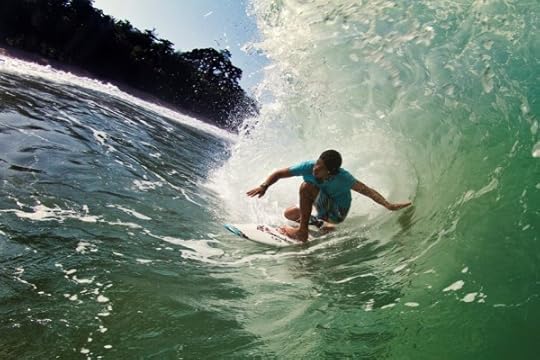
Photo: … your local connection
1. Costa Ricans call themselves ticos (males) and ticas (females).
2. It’s not a big deal to see someone walking around with a machete.
Although it’s more common in the countryside, ticos use machetes for everything and often keep one on them. They’re considered the Costa Rican equivalent of duct tape.
3. Costa Rica is only slightly smaller than Lake Michigan.
And has 801 miles of coastline.
4. Ticos often refer to their significant others as their “media naranja”.
Which means “the other half of their orange.”
5. Costa Rica’s president, Luis Guillermo Solís, won the 2014 election with over 77% of the vote.
This was the largest margin ever recorded for a free election in Costa Rica. Previously, Costa Rica’s president was Laura Chinchilla, Costa Rica’s first female president and sixth female elected for president of a Latin American country.
6. Costa Rica has more than 121 volcanic formations, with seven of them being active.
Poás Volcano has the second widest crater in the world, and Arenal is one of the ten most active volcanoes in the world.
7. The country is host to more than 5% of the world’s biodiversity.
Even though its landmass only takes up .03% of the planet’s surface, more than 10% of the world’s butterflies live here — there are about 750,000 species of insects that live in Costa Rica, and 20,000 various kinds of spiders.
8. Costa Rica has no standing army.
They abolished the army in 1948 after their last civil war ended.
9. Costa Rican women don’t take their husband’s last name.
And instead use their full maiden name for life. Children take their father’s name but add their mother’s maiden name to their full name.
10. Instead of saying a woman “had a baby,” ticos say “ella dio a luz.”
Meaning, “she gave light.”
11. Every Costa Rican radio station plays the national anthem every morning at 7am.
12. Until a few years ago, wearing shorts was a sign of disrespect.
And government buildings wouldn’t allow visitors to enter unless they were wearing long pants.
13. Pedestrians are called “targets.”
And speed bumps are called “son muertos” — in English, “(they are) dead people.”
14. Costa Rica is considered one of the most valued environmental destinations in the world.
There are over 100 protected areas to visit, and 25% of the country has protected forests and reserves.
15. Ice cream flavors in Costa Rica are interesting and sometimes slightly weird.
Flavors include coconut, goat cheese, wild blackberry, peanut, sour cream, chipotle blueberry, chocolate almond, and more.
16. You could easily call Costa Rica the unofficial hummingbird capital.
The country is home to over 52 species of hummingbird.
17. Pura Vida is a happy, feel-good expression.
Pura Vida is used regularly by the locals when asked how they are or in passing to say hello or goodbye.
18. Costa Rica has an exceptionally high life expectancy of 79, one of the highest in the world.
And receives international praise for its modern healthcare system, where it’s ranked 36th in the world by the World Health Organization (WHO). The Nicoya Peninsula is one of the world’s seven Blue Zones, a place where people live longer and happier lives, and has a high concentration of people over age 100.
19. There are usually no street names or addresses.
So people simply get accustomed to giving directions via landmarks. When giving someone a home address, ticos usually say something like, “It’s the blue house just south of where the cow is tied up,” or “It’s 500 meters north of the big tree.”
20. Mae is the Costa Rican slang term for “dude.”
And is used regularly in conversation with young people.
21. Costa Rica has a 96% literacy rate.
In rural areas of the country where ticos are very poor and don’t have access to school, classes are taught on air over a national radio station. 
June 12, 2014
Yes, gay men play sports too
NO ONE SHOULD NEED “PERMISSION” to be themselves. But one of the biggest and worst stereotypes I’ve encountered are the ones that try to link sports to homosexuality.
“Girls who play sports are lesbians,” or “Guys who play sports aren’t gay” are two of the more common things I’ve heard over the years, but they give you a good idea of what many people in the world believe. I think it’s incredibly brave when anyone in the limelight, not just athletes, comes out to the public, because it helps us change the way we view LGBTQ culture.
In light of the craziness that is the 2014 FIFA World Cup, I hope that people set aside their prejudices and focus more on the awesomeness that is soccer. I hope they can appreciate the feeling of pride at having their culture and country represented during this time, and that they can cheer on the members of their favorite teams, regardless of who the athletes choose to love in return. 
10 best World Cup goals of all time
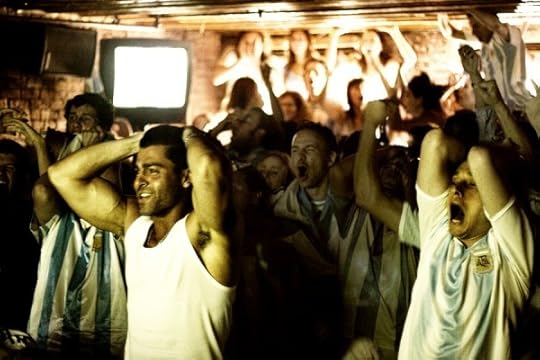
Photo: Moazzam Brohi
WHILE THIS YEAR’S WORLD CUP is sure to have its fair share of electrifying strikes, years past have shown us the same. Take a look at 10 of our favorite World Cup goals of all time, in no particular order.
Diego Maradona: Argentina vs England, 1986
No, it’s not the notorious “Hand of God” goal. This one came less than 5 minutes later during the same game. Upon receiving the ball, Maradona turned on the jet engines and covered 60 meters in 10 seconds, dribbling past four English defenders (Terry Butcher had the joy of being juked around twice) and goalkeeper Peter Shilton before releasing the ball into an open goal. Though still up for debate, the goal was voted the FIFA World Cup Goal of the Century in 2002 by fans from all over the globe.
Dennis Bergkamp: Netherlands vs Argentina, 1998
It took Dennis Bergkamp less than 2.5 seconds to formulate a solution to the 1-1 score during the 90th minute of the quarterfinal match between Holland and Argentina: three precision touches of the ball (all made with his right foot). With the first touch, Bergkamp gracefully reins in Frank de Boer’s long pass before megging Roberto Ayala for touch number two, only to complete the series by expertly placing the shot past goalkeeper Carlos Roa into the far top corner.
Michael Owen: England vs Argentina, 1998
A well-kept secret until this point, Michael Owen made his name known with this goal at a young 18 years of age. Receiving the ball in stride just past midfield, Owen speeds by the opposition and meets his last defender face to face. He feigns left and moves right, shaking Roberto Ayala for a split second, before firing the ball across the box into the far corner of the goal. After this one, well, Owen wasn’t such a secret anymore.
Pelé: Brazil vs Sweden, 1958
Forty years prior to Owen’s coming-of-age goal, Pelé announced himself to the world at the age of 17 with this impressive goal against Sweden in the World Cup final. Bringing down Nilton Santos’ cross with his chest, Pele flicks the ball over the defending Bengt Gustavsson before sending it past Karl Svensson with a low volley. The score of the match ended at 5-2 with Brazil victorious, giving them their first World Cup trophy — things were never the same.
Carlos Alberto: Brazil vs Italy, 1970
This time around Pelé wasn’t the scorer, but he did provide some help. The scene begins with Clodoaldo as he effortlessly maneuvers around four Italian players before passing the ball to Rivelino, who quickly finds Jairzinho downfield. Pelé fields a short pass from Jairzinho before delivering the ball to a Carlos Alberto, moving at full-speed, who rips the ball into the opposing goal. Already far ahead on the scoreboard, Brazil brings the trophy home once again.
Saeed Al-Owairan: Saudi Arabia vs Belgium, 1994
Saeed Al-Owairan went on a solo mission to score this goal in Saudi Arabia’s 1994 World Cup match against Belgium. In 2002, his goal received the sixth-most votes for FIFA World Cup Goal of the Century. Five minutes into the match, the midfielder received a pass and set off running. He kept running, shimmying past several players in the process, until finding the opportunity to send the ball zooming past Michel Preud’homme for the goal. Al-Owairan’s showmanship and efforts kept Saudi Arabia’s World Cup 1994 hopes alive, later dashed by Sweden in the Round of 16.
Roberto Baggio: Italy vs Czechoslovakia, 1990
Often touted as the “goal of the tournament,” Baggio’s goal against Czechoslovakia in 1990 is one to remember. Off a one-two with Giuseppe Giannini, Baggio dribbles the ball all the way to the penalty box, splitting much of the defense in the process. Feigning left and losing his final defender, Baggio zips the ball past the goalie from the direct center of the penalty area to score. The mullet and the missed penalty kick are equally memorable, unfortunately.
Gheorghe Hagi: Romania vs Colombia, 1994
Playing in Pasadena during 1994’s World Cup, Hagi received a short ground pass just past midfield. After a handful of short dribbles, he releases the ball with a long-distance lob. Colombian goalkeeper Oscar Cordoba leaps, hand stretched in the air, but there is little that he could do. The ball hits the back of the net. The Romanians celebrate as they continue on their path to the quarterfinals.
Esteban Cambiasso: Argentina vs Serbia and Montenegro, 2006
Argentina routed Serbia and Montenegro in their 6-0 victory during 2006’s World Cup, and the 24-pass series culminating in Cambiasso’s goal is the perfect summary. The Argentines casually passed the ball between themselves over the course of nearly 90 seconds before Cambiasso, 12 yards out, received the ball off a nice backheel and smashed it into the back of the net. The goal was a picture-perfect demonstration of Argentina’s style.
Arie Haan: Netherlands vs Italy, 1978
Arie Haan’s most famous goal was his 40-yard shot against Italy in the second group stage of 1978’s World Cup. Haan wound up and ignited a long-distance strike towards the Italian goal. Dino Zoff, the Italian goalkeeper, leapt and extended in an effort to stop the attempt but was unsuccessful as the ball bounced off the goalpost and ricocheted into the back of the net. 
Matador Network's Blog
- Matador Network's profile
- 6 followers



